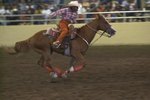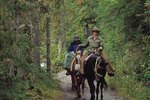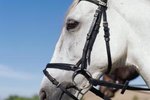Western saddles have horizontal bars on the frame that connect the front fork of the saddle to the cantle, or rear of the rider's seat. Full quarter horse bars have a wider fork, or width, that rests on the horses shoulders than semi-quarter horse bars.
Western Saddle Parts
The front part of a Western saddle includes the saddle horn on top, the fork underneath that extends down vertically and the gullet, or open area in the front center of the saddle. When looking at a Western saddle from the front, these parts look like a wishbone.
Horse Measurements
Measuring your horse for the correct saddle size is done with a flexible wire. After cutting a 16-inch length of baling wire, mark the center with a marker and center the mark on top of your horse's withers. His withers are the shoulder blades at the highest point. Gently bend the wire to form a shape next to your horse on his withers while gently touching his skin. After removing the wire, measure down 3 inches from the center at the top and take a horizontal measurement between the two wires at this point. This measurement is for the gullet height and width. Measure horizontally between the bottom two wire tips for the bar width your horse requires.
Bar Measurements
Semi-quarter horse bars measure 6 inches apart on your measuring tool. This size saddle fits a horse who is healthy without excess fat or muscles on his upper shoulders. Full quarter horse bars are 6 1/4 to 6 1/2 inches apart. This size fits horses who are wider in the front shoulders than a semi-quarter horse bar size with extra muscle or fat. As horses age, they may gain weight and need a larger bar saddle or they may become leaner, lose weight and require a smaller bar saddle.
Ill-Fitting Saddles
Western saddles that do not fit a horse well can cause a large number of problems, both physical and behavioral when riding a horse, explains Dr. Joyce Harman, DVM. Bars that are not wide enough rub painful saddle sores onto the horse's skin and can make withers sore and swell after a ride or training session. Horses with the wrong size saddle bars may be hypersensitive to brushing and object to being saddled. An ill-fitting saddle can cause, excessive tail-swishing, pinning ears, teeth grinding and head tossing that increase as the ride progresses.
References
Photo Credits
-
nigelb10/iStock/Getty Images
Writer Bio
Mary Lougee has been writing for over 10 years. She holds a Bachelor's Degree with a major in Management and a double minor in accounting and computer science. She loves writing about careers for busy families as well as family oriented planning, meals and activities for all ages.





